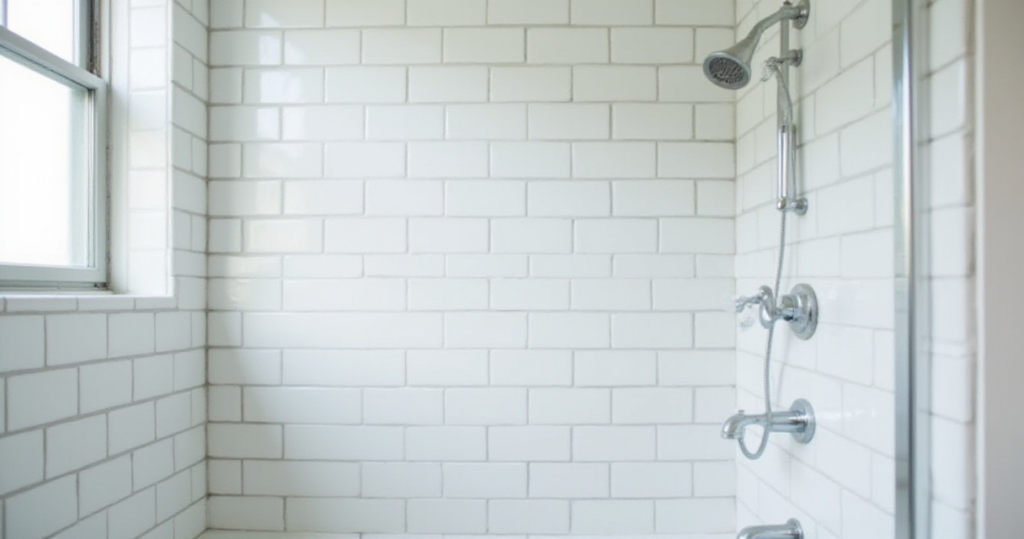In the dance between fleeting trends and enduring style, bathroom design presents a unique challenge. Here, we seek both beauty and function in a space that must withstand moisture, heavy use, and changing tastes. While design magazines showcase the latest fads, there’s wisdom in turning to elements that have already proven their staying power.
These bathroom design classics aren’t just reliable—they’re storytellers. Each brings its own history and character while creating spaces that feel both fresh and grounded. From the humble subway tile born in New York’s underground to the elegant curves of clawfoot tubs that have graced homes for centuries, these elements speak a design language that transcends time.
As a specialist in cultural design integration, I’ve witnessed how these classics provide the perfect canvas for personal expression. They allow you to honor tradition while creating spaces uniquely yours. Let’s explore 19 bathroom design classics that continue to captivate our imagination and enhance our daily rituals.
1. The Ever-Versatile Subway Tile
Subway tile carries a fascinating origin story—born in 1904 in New York City’s underground transit system where designers needed something durable, clean, and light-reflective. This practical beginning established its reputation for hygiene and utility, quickly moving from public spaces into residential bathrooms where it became synonymous with cleanliness and refined design.

What makes subway tile a true bathroom design classic is its remarkable versatility. The clean lines of the traditional 3×6 rectangular format adapt to virtually any style, from Victorian-inspired spaces to minimalist modern retreats. Available in countless materials, colors, and installation patterns—herringbone, vertical stack, basketweave—it provides endless creative possibilities while maintaining its timeless appeal.
The inspiration for this collection struck when I visited a century-old home in Mexico City, where original subway tile had been enhanced with hand-painted Talavera accents, creating a beautiful dialogue between classic structure and cultural expression.
2. The Elegant Pedestal Sink
The pedestal sink emerged in the late 19th and early 20th centuries as a more hygienic alternative to wall-mounted sinks with exposed plumbing. Its sculptural form—a basin supported by a freestanding column—creates visual space in the bathroom, making even small powder rooms feel more open and airy.
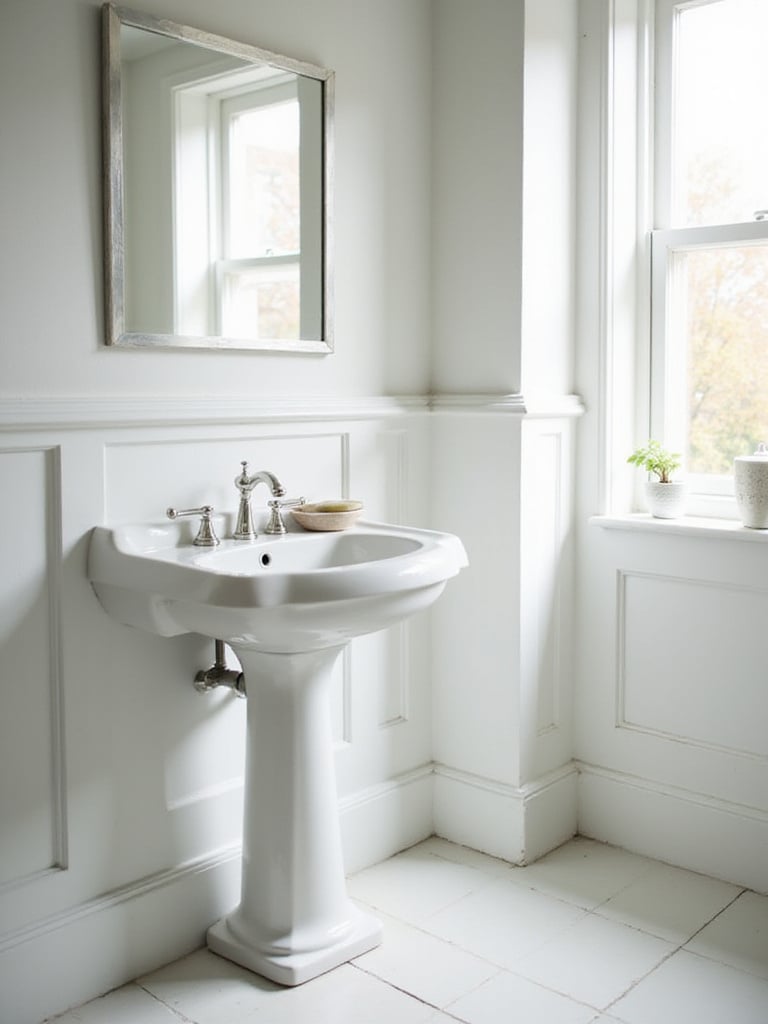
This bathroom design classic offers timeless elegance while solving practical challenges. Its space-saving silhouette maximizes floor area, while its clean lines complement everything from traditional to contemporary styles. Though it sacrifices storage space, its architectural presence and easy-to-clean design have ensured its enduring popularity in bathrooms where aesthetics are paramount.
Many homeowners wonder how to balance the pedestal sink’s beauty with practical storage needs—the solution often lies in complementary elements like recessed medicine cabinets, floating shelves, or decorative baskets that maintain the open feeling while providing homes for necessities.
3. The Iconic Clawfoot Bathtub
Few bathroom elements make as powerful a statement as the clawfoot bathtub. With its freestanding design elevated by decorative feet—often resembling lion’s paws—it transforms an everyday fixture into a sculptural centerpiece. These tubs reached peak popularity during the late 19th century when indoor plumbing was revolutionizing domestic life.
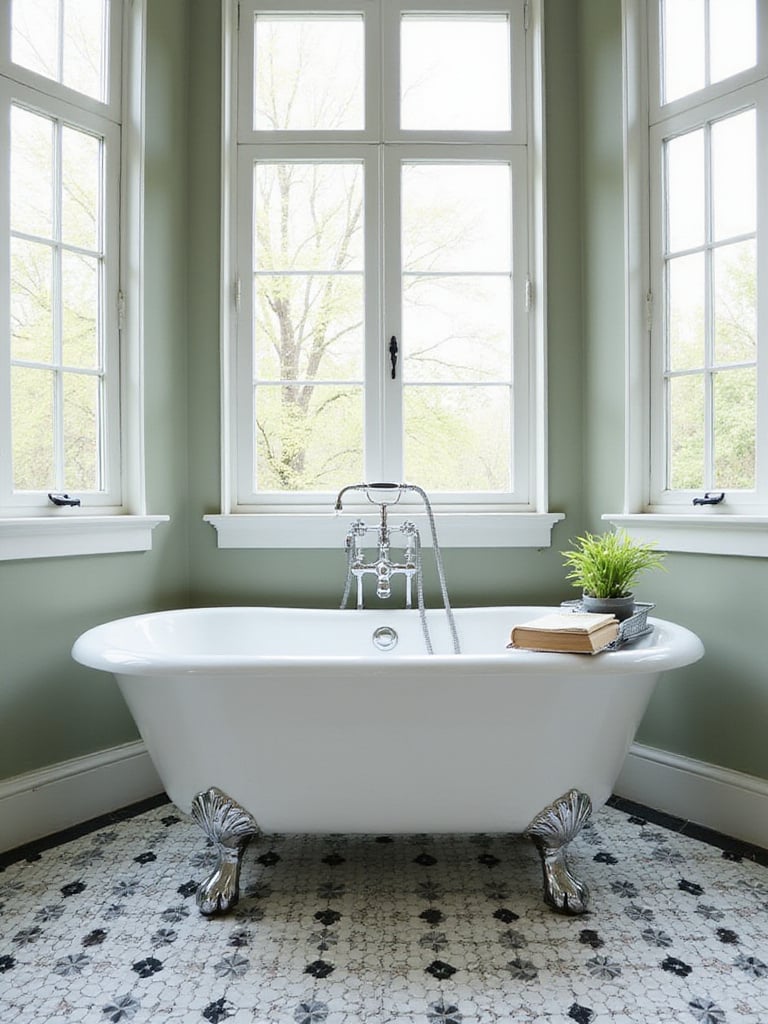
What makes this bathroom design classic so enduring is its perfect balance of luxury and character. The exposed form creates a sense of spaciousness, while the deep basin promises indulgent soaking. Originally crafted from cast iron with porcelain enamel, today’s versions also include lighter materials like acrylic, making this classic more accessible while maintaining its distinctive silhouette.
“The clawfoot tub isn’t just a bathtub—it’s a celebration of ritual, a nod to history, and a declaration that self-care deserves beautiful surroundings.”
Running your hand across this material reveals the subtle temperature variations unique to these tubs—cool to the touch when you enter, gradually warming to create a cocoon-like embrace that modern built-ins simply cannot replicate.
4. Classic Hexagon Floor Tiles
Hexagon tiles have adorned bathroom floors since the Victorian and Edwardian eras, their six-sided geometry offering a visually intriguing alternative to simple squares. This honeycomb-inspired pattern creates a sense of movement and depth that flat squares simply cannot achieve, making floors come alive with subtle visual texture.
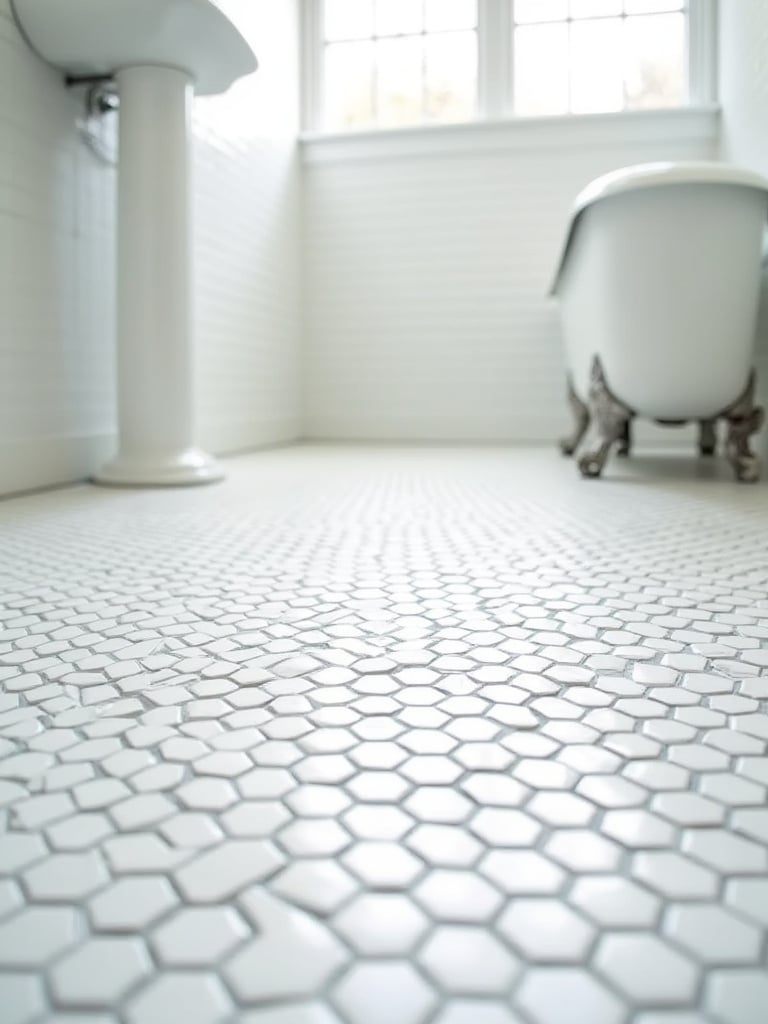
The endurance of this bathroom design classic stems from both practical and aesthetic considerations. The small format provides excellent slip resistance in wet areas, while the interlocking pattern distributes weight evenly for structural stability. Traditionally rendered in white ceramic with black accents, today’s interpretations include everything from marble to porcelain in countless color combinations, allowing this historic pattern to feel completely contemporary.
The unexpected environmental benefit comes from the hexagon’s efficient use of material—its shape is one of the most economical for covering a flat surface without gaps, which is why it appears so frequently in nature, from honeycomb to molecular structures.
5. Timeless Marble Countertops and Walls
Marble has graced luxurious spaces for millennia, from ancient Roman baths to Renaissance palaces, carrying with it an inherent sense of quality and permanence. Its unique veining patterns ensure no two installations are identical, making each marble bathroom a truly one-of-a-kind expression.
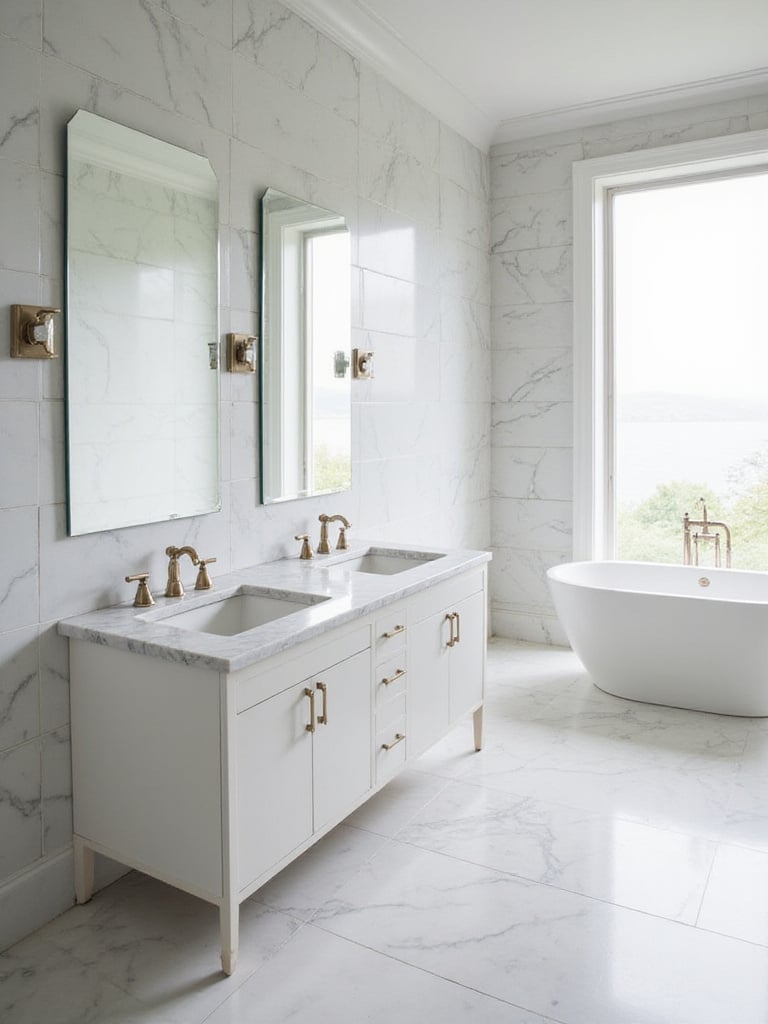
As a bathroom design classic, marble offers unmatched natural beauty and tactile pleasure. The cool, smooth surface provides a sensory experience that manufactured materials cannot replicate. Varieties like Carrara (with soft gray veining), Calacatta (more dramatic with gold undertones), and Nero Marquina (striking black with white veins) each create distinct moods while maintaining the material’s timeless appeal. Though requiring more maintenance than engineered surfaces, marble’s ability to patina gracefully over time adds to its enduring charm.
The material sourcing makes all the difference in how marble performs in bathroom settings—stones from different quarries have varying density and porosity, affecting their resilience in humid environments. Working with knowledgeable suppliers helps ensure you select the right variety for your specific needs.
6. Sleek and Durable Chrome Fixtures
Chrome fixtures have illuminated bathrooms for nearly a century, their reflective surfaces bringing brightness and a sense of precision to the space. The electroplating process, developed in the early 20th century, revolutionized bathroom design by creating hardware that could withstand moisture while maintaining its brilliant shine.
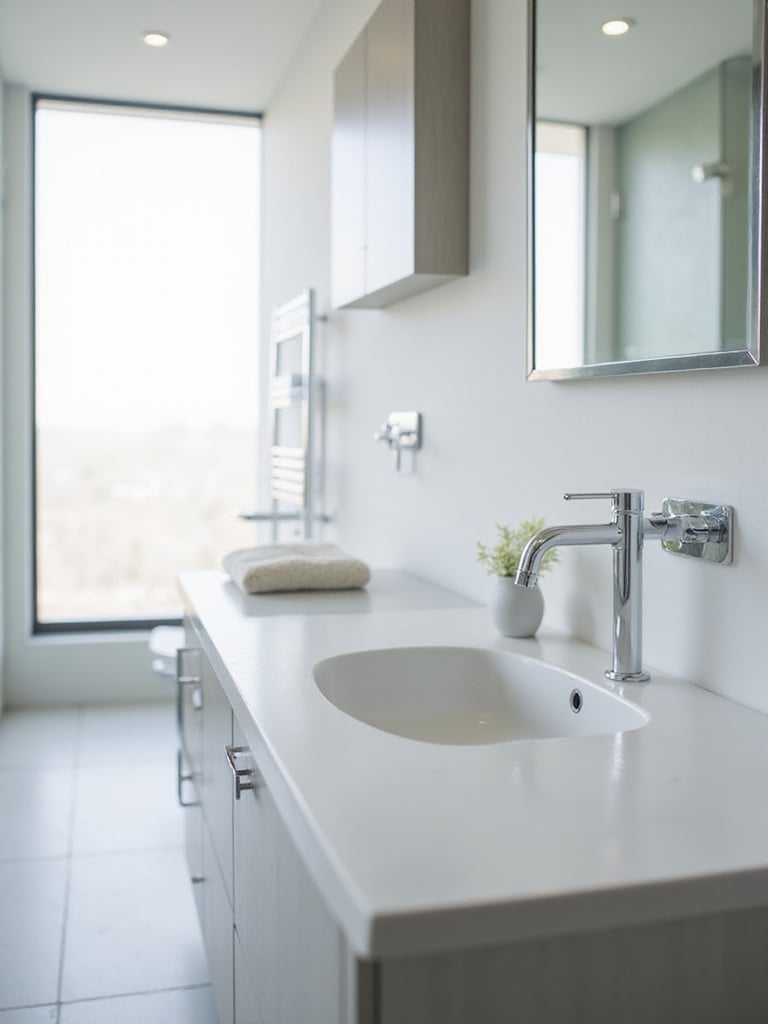
This bathroom design classic earns its status through unmatched versatility and performance. Chrome’s neutral brightness complements virtually any color scheme or style, from traditional to ultra-modern. Its high reflectivity helps brighten smaller bathrooms, while its resistance to corrosion ensures longevity in humid conditions. Perhaps most importantly, chrome shows water spots less than matte finishes and cleans easily with a quick wipe, making maintenance practically effortless.
The unexpected pairing that always works is chrome fixtures against natural materials like wood or stone—the contrast between industrial precision and organic texture creates dynamic tension that keeps bathroom design feeling fresh and balanced.
7. Crisp White Porcelain Fixtures
White porcelain fixtures—sinks, toilets, and tubs—form the foundation of countless beautiful bathrooms. Their pristine surfaces symbolize cleanliness and purity, values that are fundamental to bathroom design. Modern fixtures, crafted from vitreous china, undergo high-temperature firing that creates a non-porous, glass-like finish resistant to stains and bacteria.
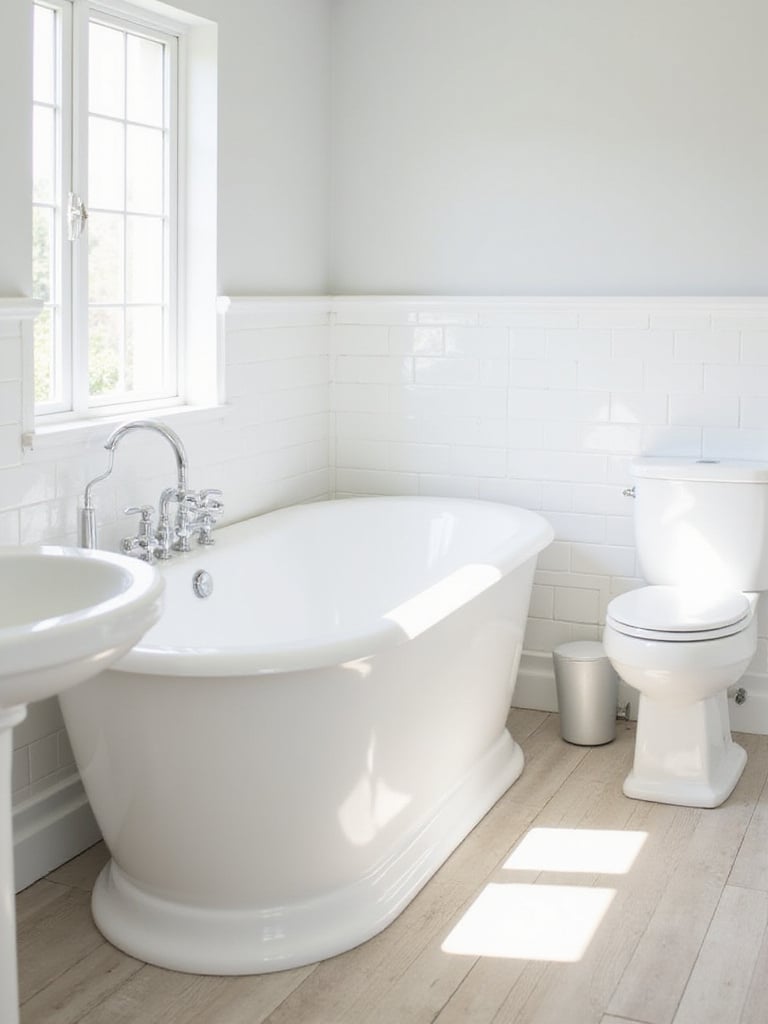
The unrivaled versatility of this bathroom design classic allows it to serve as a neutral canvas for any style expression. White porcelain complements every color palette, every time period, and every design approach, from minimalist to maximalist. It reflects light beautifully, making spaces feel larger and brighter. Most importantly, it maintains its appeal across decades, ensuring your core fixtures won’t require updating with each passing trend.
The craftsmanship reveals itself in details like the perfectly smooth glazing that allows water to sheet off without pooling, the precision of edges where surfaces meet, and the substantial weight that signals quality and durability—elements that distinguish truly fine porcelain from lesser alternatives.
8. The Discreet Recessed Medicine Cabinet
The recessed medicine cabinet exemplifies form following function in the most elegant way possible. Unlike surface-mounted versions that protrude into the room, these cabinets nestle between wall studs, creating storage without sacrificing space—a particularly valuable feature in smaller bathrooms.
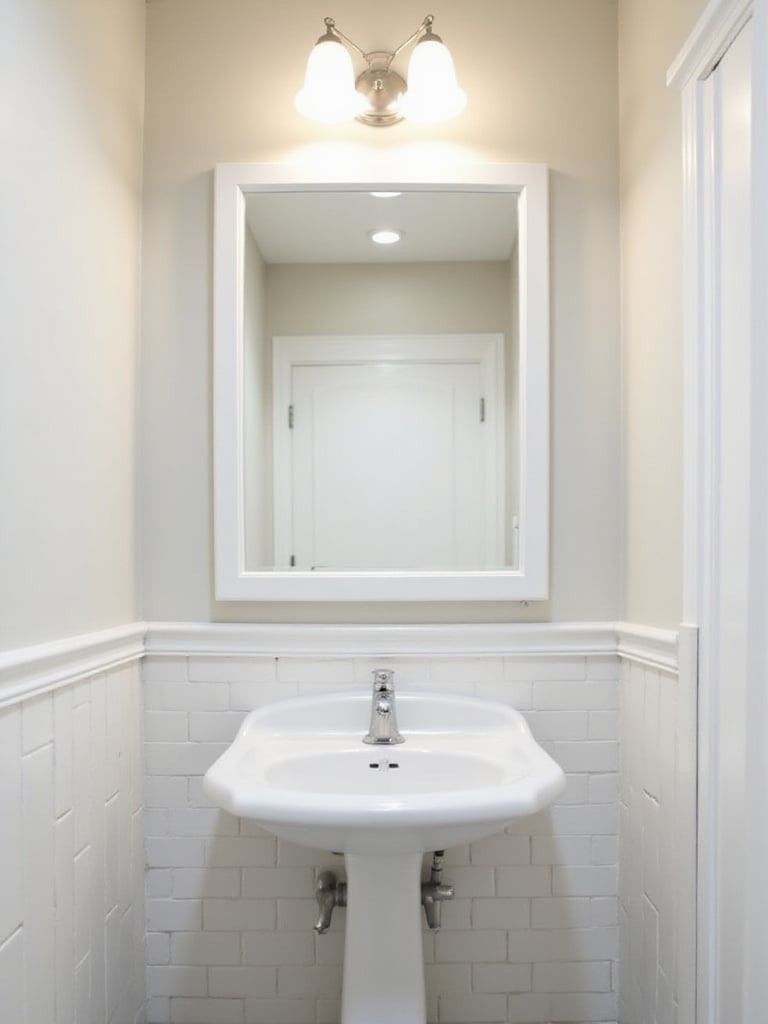
This bathroom design classic maintains its relevance by solving practical problems while preserving visual harmony. The mirrored door, sitting flush with the wall, creates a sleek, uninterrupted surface that enhances minimalist designs or integrates subtly into traditional ones. Behind this streamlined exterior lies valuable storage for everyday essentials, keeping countertops clear and contributing to the serene environment we crave in our personal spaces.
The styling mistake most people make is choosing a recessed cabinet that’s too small for their needs—remember that the goal is to conceal all your everyday items, so measure your actual products and select a cabinet with sufficient depth and interior configuration to accommodate them comfortably.
9. Charming Beadboard Wainscoting
Beadboard wainscoting brings texture and architectural interest to bathroom walls while serving the practical purpose of protecting surfaces from moisture and wear. Characterized by vertical planks with distinctive “beads” or grooves between them, this treatment typically covers the lower portion of walls, creating visual division that adds dimension to the room.
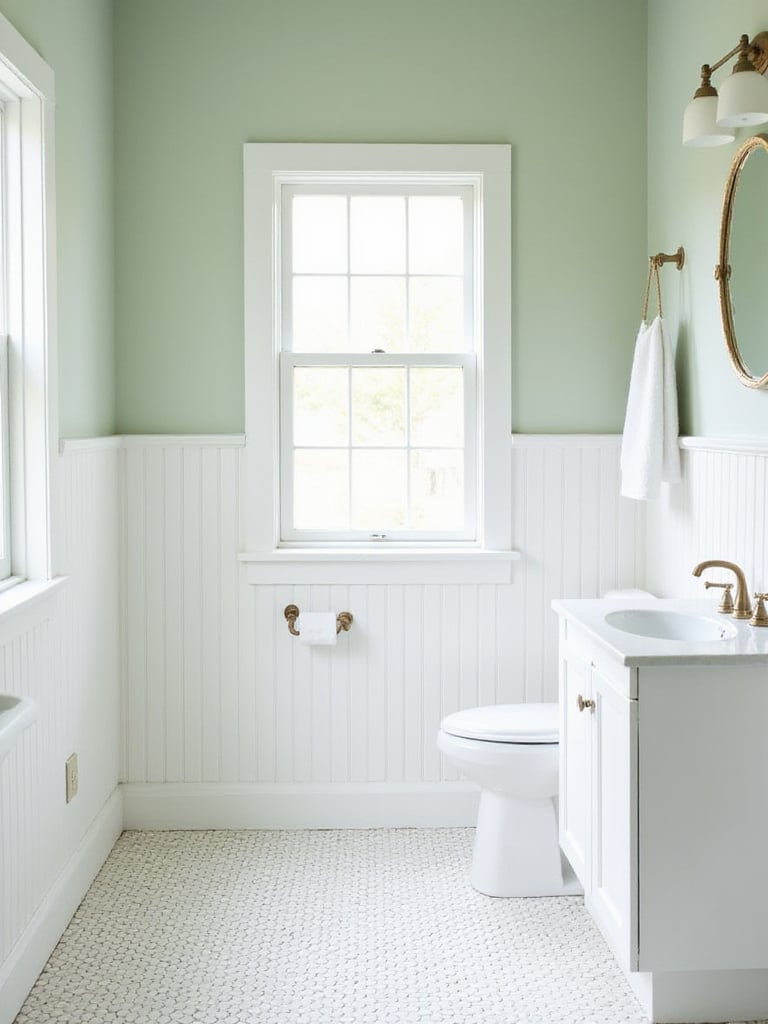
This bathroom design classic bridges various styles with remarkable ease. It feels perfectly at home in cottage, farmhouse, and traditional settings, yet can also provide unexpected textural contrast in more contemporary spaces. While traditionally crafted from wood, today’s moisture-resistant versions in MDF or PVC offer greater durability in humid environments without sacrificing the distinctive look that has made beadboard a perennial favorite.
The cultural heritage preserved in each piece includes echoes of early American craftsmanship, when hand-planed beadboard was created not just for decoration but as a practical solution for walls that could withstand the rigors of daily life—a purpose it continues to serve beautifully in modern bathrooms.
10. A Simple, Classic Framed Mirror
A well-proportioned framed mirror transforms the necessary act of reflection into an opportunity for design expression. Unlike frameless utilitarian mirrors, a classic framed version with clean lines and quality materials elevates the entire bathroom, providing definition and visual anchor above the vanity.
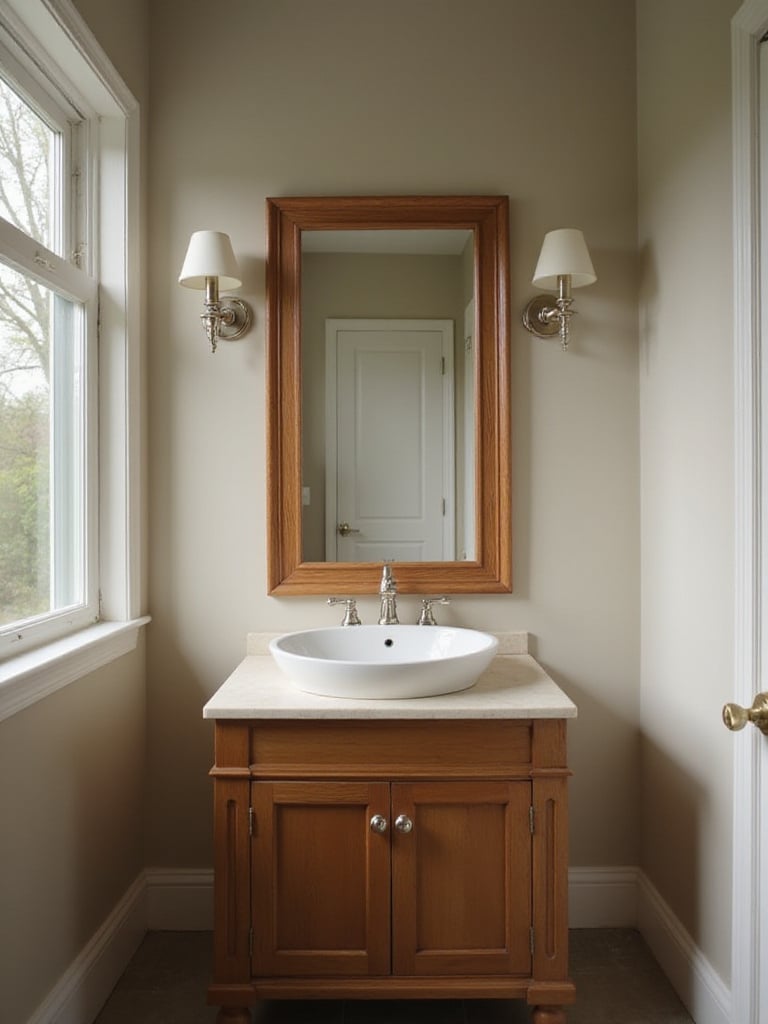
What makes this bathroom design classic so enduring is its ability to bridge functional necessity and aesthetic refinement. The frame adds a finished quality, concealing edges while protecting the mirror itself. Available in countless materials—from natural wood to metal in various finishes—these mirrors can tie into other elements within the space, creating cohesion. Their simplicity ensures longevity, as they’re less likely to appear dated than more ornate or trend-driven alternatives.
The designer’s secret here is to choose a frame width proportional to the mirror size and room scale—too thin can look insubstantial, while too thick may overwhelm the space. The most versatile options maintain a balance that complements rather than dominates.
11. Balanced Sconce Lighting
Balanced sconce lighting flanking a bathroom mirror isn’t just beautiful—it’s the most functional approach to illumination for personal grooming. Unlike overhead lights that cast unflattering shadows, sconces at eye level provide even, shadow-free light that accurately renders skin tones and makes tasks like applying makeup or shaving significantly easier.
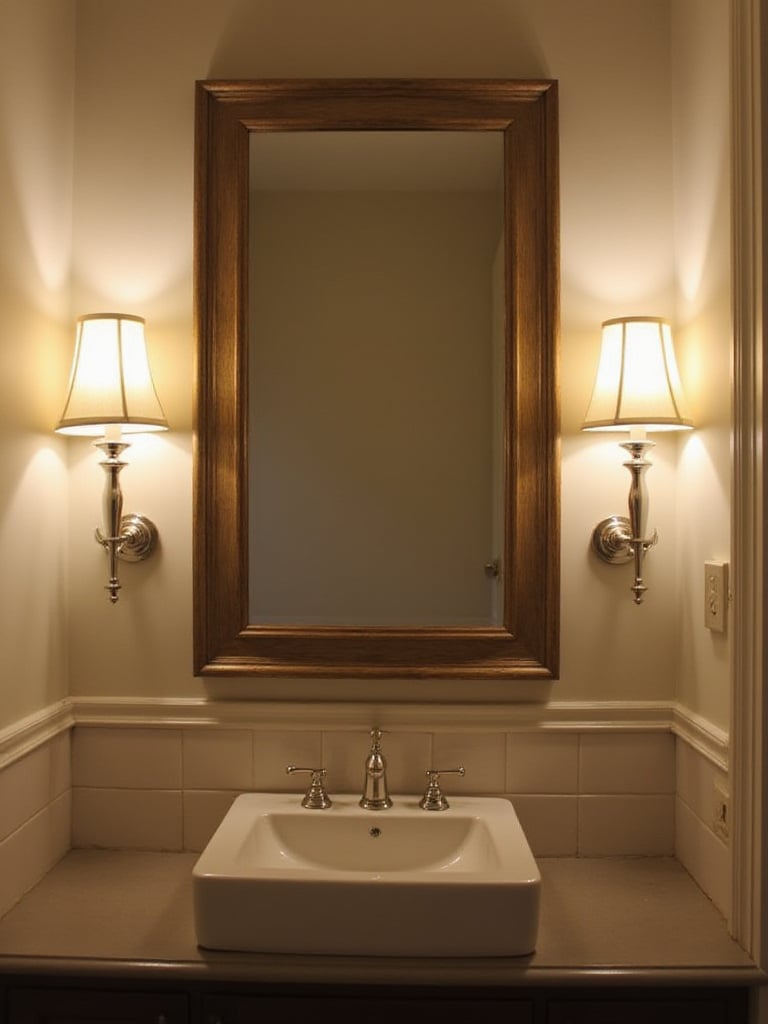
This bathroom design classic demonstrates how thoughtful lighting transforms both function and mood. Beyond their practical benefits, symmetrical sconces create visual balance and serve as decorative elements that can reinforce the room’s style. Available in countless designs from sleek and modern to ornate and traditional, they contribute to the layered lighting scheme that every well-designed bathroom requires.
As morning light filters through, the texture creates beautiful interplay with sconce illumination, highlighting different aspects of the bathroom throughout the day—a dynamic quality that purely overhead lighting cannot achieve, making this classic pairing essential for bathrooms that feel alive and responsive.
12. A Classic Freestanding Vanity
The freestanding vanity brings furniture-like presence to the bathroom, its independent structure and often detailed legs creating a sense of airiness compared to built-in cabinetry. This bathroom design classic typically features solid wood construction, traditional joinery, and thoughtful proportions that give it the character of a carefully chosen piece rather than standard cabinetry.
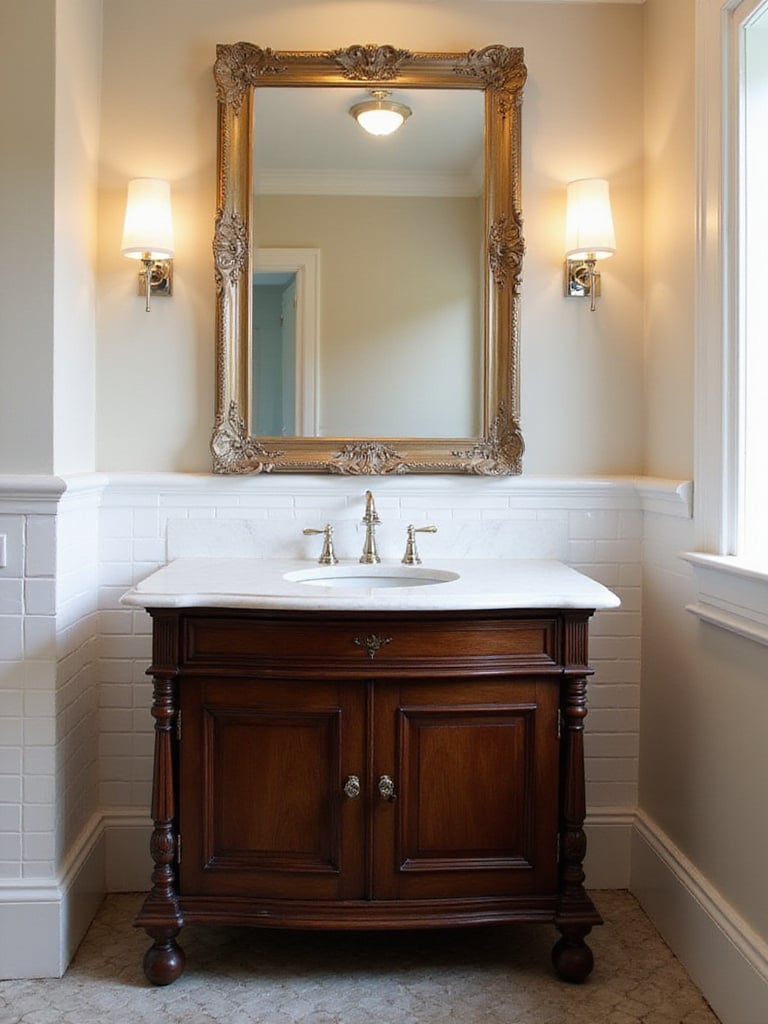
What makes this element endure across decades is its unique ability to add warmth and personality to what might otherwise feel like a purely utilitarian space. The visible floor beneath creates a sense of spaciousness, while the furniture-like quality adds sophistication. Available in countless styles from antique to contemporary, freestanding vanities offer versatility while maintaining the timeless appeal that comes from quality materials and craftsmanship.
The third-generation workshop where this comes to life often employs techniques passed down through families—mortise and tenon joints, hand-selected wood grain matching, and traditional finishes that develop character over time, creating pieces that feel substantially different from mass-produced alternatives.
13. Vintage-Inspired Cross-Handle Faucets
Cross-handle faucets bring tactile pleasure and visual interest to daily rituals. Their distinctive X-shaped handles, often featuring porcelain or metal accents, offer both practical grip and decorative detail. Rooted in the early days of indoor plumbing, they carry historical resonance while functioning beautifully in contemporary settings.

This bathroom design classic balances form and function in perfect measure. The quarter-turn operation provides precise water control, while the separate hot and cold handles allow users to adjust temperature exactly to their preference. Beyond practicality, these fixtures add character through their three-dimensional form and often intricate detailing—small sculptures that enhance the bathroom’s visual appeal while serving essential daily needs.
- Available in various finishes including chrome, nickel, brass, and bronze
- Often feature porcelain, crystal, or metal accent details
- Separate hot and cold controls for precise temperature adjustment
- Quarter-turn operation for water flow control
What makes this design special is the way it engages multiple senses—the cool touch of metal, the satisfying resistance of the mechanism, the visual pleasure of well-executed craftsmanship—creating moments of mindfulness during routine activities.
14. Intricate Basketweave Floor Tile
Basketweave tile brings subtle texture and historical depth to bathroom floors. This pattern, characterized by rectangular tiles arranged to mimic the over-under rhythm of woven baskets, often incorporates small square “dots” at intersections for enhanced visual interest. Popular from the early to mid-20th century, it carries associations with quality craftsmanship and attention to detail.
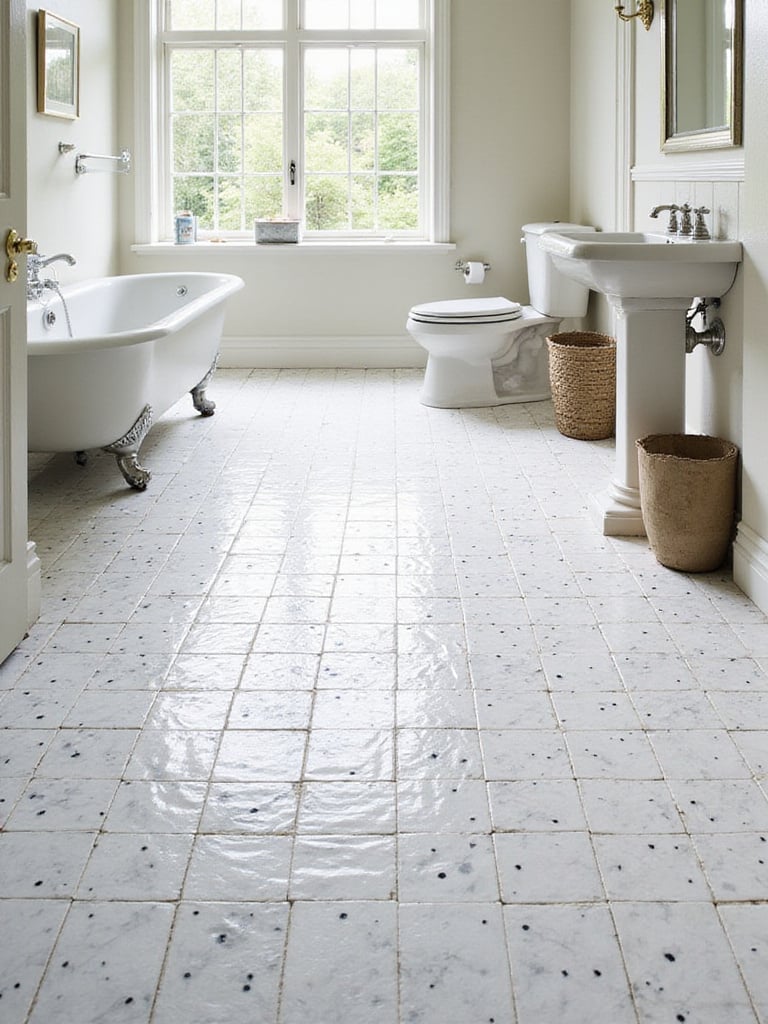
As a bathroom design classic, basketweave tile offers practical benefits alongside aesthetic appeal. The intricate pattern provides excellent slip resistance, while the small scale creates visual interest without overwhelming the space. Traditionally executed in contrasting black and white, modern interpretations include various materials and color combinations, allowing this heritage pattern to feel completely contemporary.
The visual weight balances perfectly when basketweave flooring is paired with simpler wall treatments—the intricate floor becomes a foundation that grounds the space while allowing other elements to shine without competition or visual clutter.
15. Practical Built-In Storage
Built-in storage represents bathroom design at its most thoughtful, utilizing otherwise wasted space within walls and architectural features to create homes for everyday essentials. From recessed medicine cabinets to shower niches and custom cabinetry, these elements maximize functionality without sacrificing floor space or visual calm.
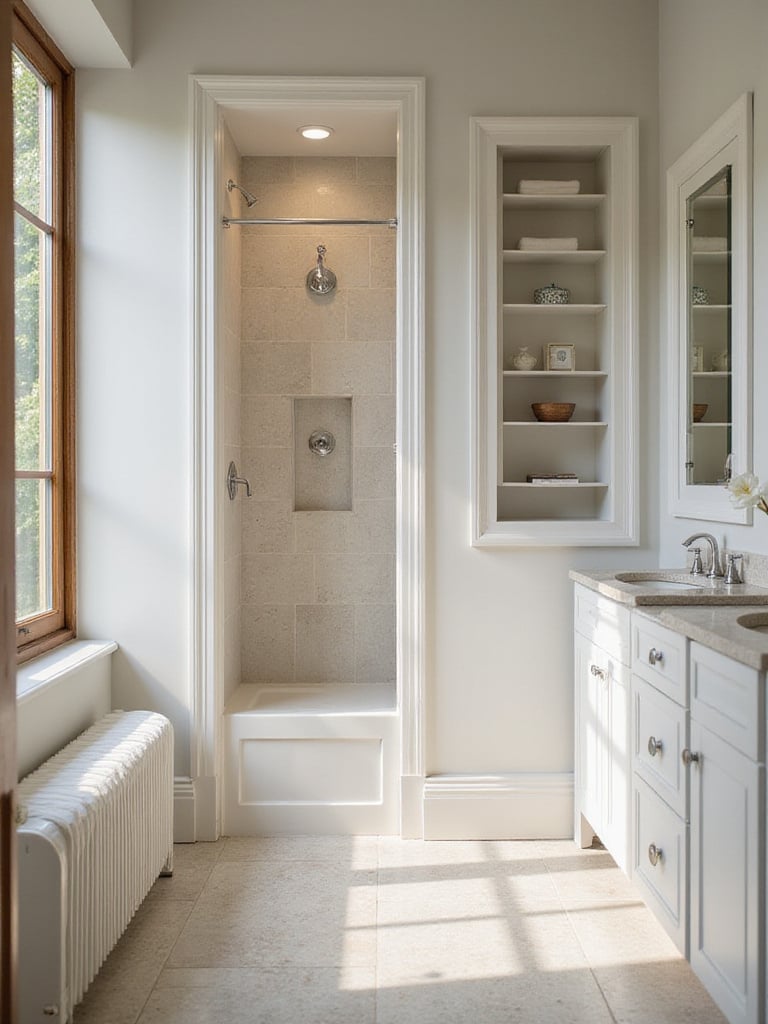
This bathroom design classic remains relevant because it addresses the fundamental challenge of keeping necessary items accessible yet unobtrusive. By integrating storage into the architecture itself, these solutions maintain clean lines while providing dedicated homes for everything from toiletries to towels. The result is a space that feels intentionally designed rather than adapted, with clutter contained and surfaces free for both use and visual appreciation.
For those worried about maintenance… built-in storage actually simplifies cleaning by reducing the number of freestanding elements that collect dust and require moving during routine care, making it not just aesthetically pleasing but practically superior to afterthought storage solutions.
16. A Clean, Simple Glass Shower Enclosure
Glass shower enclosures transform bathrooms through transparency and light. Unlike opaque curtains or heavily framed enclosures that create visual barriers, clear glass allows the eye to travel through the space uninterrupted, making even modest bathrooms feel more expansive and connected.
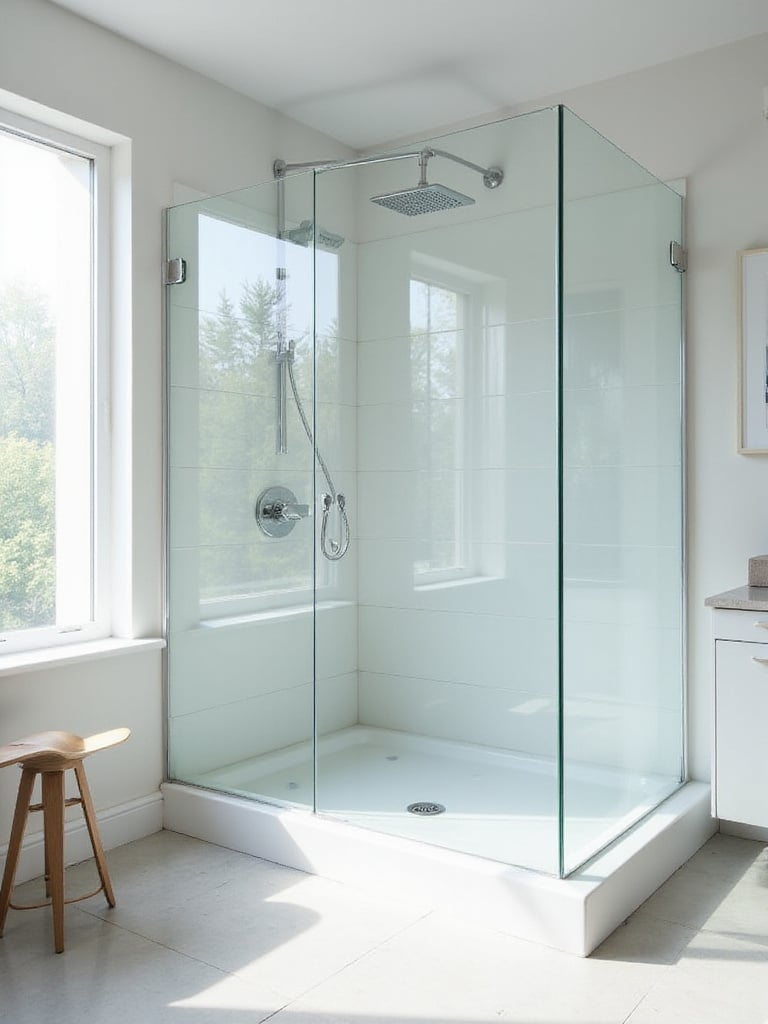
This bathroom design classic earns its status through both aesthetic and practical merits. Visually, the minimal profile complements any style from traditional to contemporary, allowing other elements—like beautiful tile or fixtures—to remain visible. Functionally, glass resists mold and mildew better than fabric curtains and creates a more effective water barrier. Frameless or semi-frameless options with minimal hardware offer the cleanest look, emphasizing the material’s inherent elegance.
Beyond the obvious placement, consider using this for creating zones within larger bathrooms—a glass partition can separate the shower from a tub area without requiring full walls, maintaining openness while defining functional areas with architectural clarity.
17. The Standard, Reliable Toilet Design
The standard two-piece toilet—with separate tank and bowl—represents engineering that has been refined over generations. Its gravity-fed flushing system uses the weight of water to create the pressure needed for effective clearing, a brilliantly simple mechanism that requires minimal moving parts and offers exceptional reliability.

This bathroom design classic maintains its relevance through sheer dependability and adaptability. While maintaining its familiar form, it has evolved significantly in water efficiency, internal components, and comfort features. The clean white porcelain presents a neutral element that allows other design features to take center stage, while its standardized dimensions ensure compatibility with most bathroom layouts.
While designed for the living room, we’ve seen creative uses in small bathrooms where space-saving corner models or compact round-front bowls allow for comfortable use without crowding. The design’s versatility extends to various heights, now including “comfort” or “chair height” options that improve accessibility without compromising the classic silhouette.
18. Functional and Stylish Towel Bars
Towel bars blend necessity with design opportunity, providing essential function while contributing to the bathroom’s overall aesthetic. Their primary purpose—allowing towels to dry efficiently by exposing maximum surface area to air—is enhanced by thoughtful placement and quality materials that resist corrosion in humid environments.
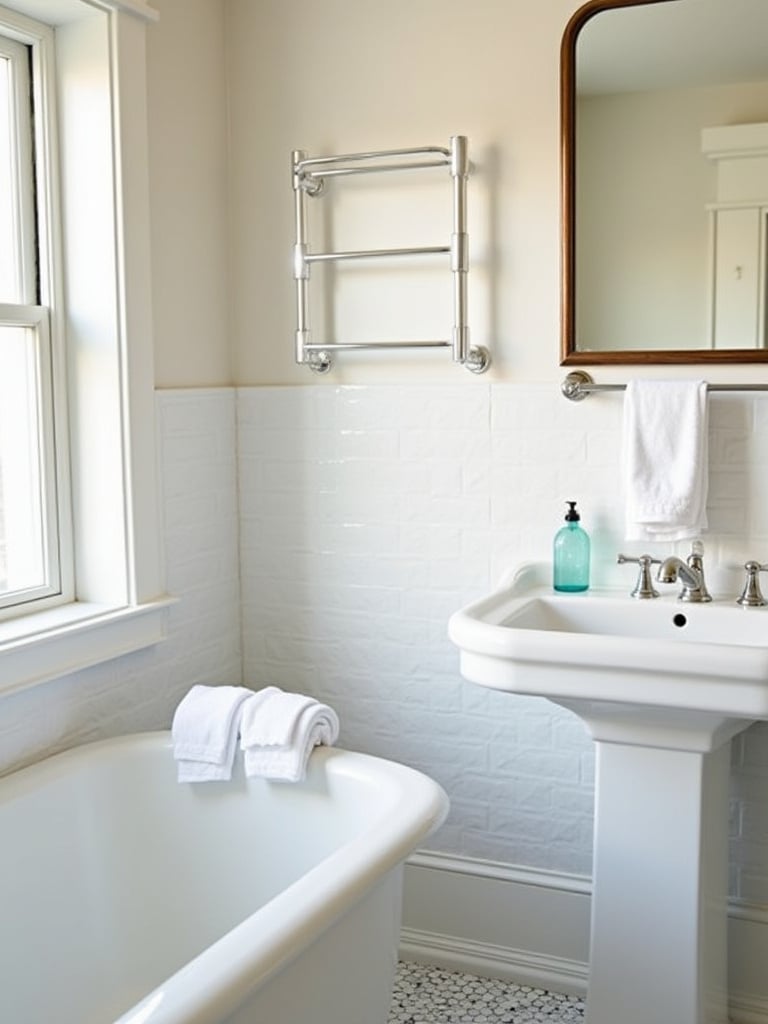
This bathroom design classic demonstrates how even utilitarian elements can be elevated through attention to detail. Available in various lengths and finishes to coordinate with other fixtures, towel bars create visual continuity while serving daily needs. Their horizontal lines can visually expand a space, while their placement offers opportunities to reinforce the bathroom’s organizational logic and flow.
The artisan collective that creates these pieces often applies traditional metalworking techniques that result in subtle variations—hand-polished surfaces that reflect light differently, slightly textured finishes that resist fingerprints, or custom patinas that develop character over time, distinguishing them from mass-produced alternatives.
19. Serene Neutral Paint Colors
Serene neutral paint colors create the perfect backdrop for bathroom design classics, allowing architectural elements and fixtures to shine while establishing a mood of calm and cleanliness. Far from boring, these sophisticated hues—soft whites, warm greys, muted greens, and gentle beiges—provide subtle depth that changes with lighting throughout the day.
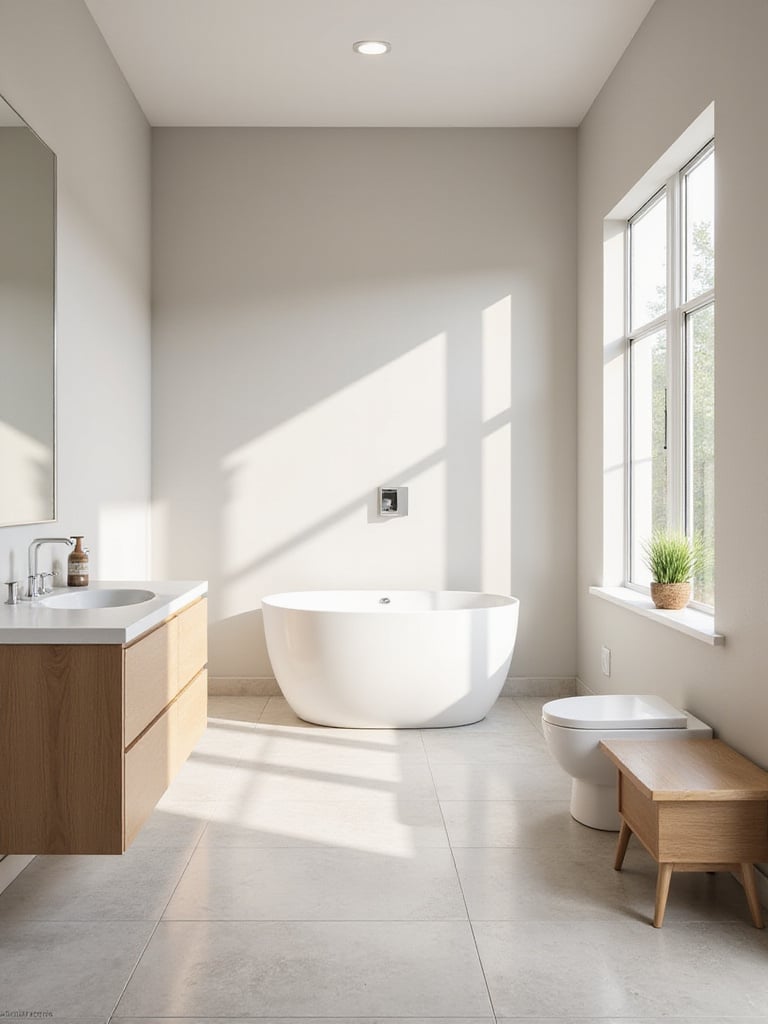
What makes these colors bathroom design classics is their remarkable versatility and staying power. Unlike bold trends that quickly date a space, neutrals create timeless foundations that accommodate evolving accessories and accents. They maximize light reflection, making spaces feel larger and brighter, while providing the perfect complement to natural materials like wood, stone, and metal that often feature in bathroom design.
The mood shifts dramatically when you add textural elements against these neutral backgrounds—plush towels, natural woven baskets, or plants bring dimension and life to the space without disrupting the fundamental serenity that makes these color choices endure across decades.
Conclusion
These 19 bathroom design classics have earned their status not through fleeting popularity but through a perfect marriage of form and function. From the humble subway tile to elegant marble, from practical storage solutions to luxurious clawfoot tubs, these elements create spaces that feel both timeless and personal.
What makes these bathroom design classics truly special is their ability to speak to both history and contemporary life. They connect us to design traditions while accommodating modern needs, creating spaces that feel grounded yet fresh. By incorporating these elements thoughtfully—perhaps subway tile with a colorful grout that references your cultural heritage, or vintage-inspired fixtures paired with contemporary art—you create a bathroom that honors tradition while expressing your unique perspective.
The most beautiful bathrooms aren’t those that rigidly follow trends or recreate museum-like period rooms, but those that thoughtfully combine these classics in ways that tell your story. They become spaces where daily rituals take place against a backdrop of enduring beauty—where the morning rush and evening wind-down happen in surroundings that feel both special and deeply comfortable. That’s the true power of bathroom design classics: they create spaces that improve with time, developing patina and meaning as they witness the rhythms of your life.
